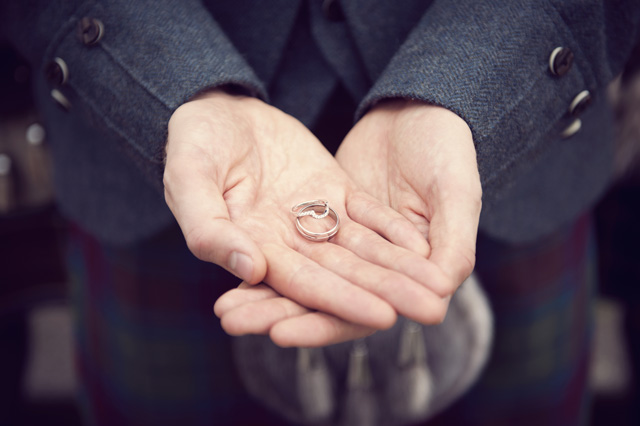Don’t be blinded by the bling while ring shopping. Beth Forsyth explores the practicalities of buying and owning the rings that’ll be with you a lifetime
Some glass-half-empty cynic suggested that marriage is a three-ring circus: engagement ring, wedding ring and suffering. The first two I have no issue with, but ‘inspiring’ would be the third in my own list. These circles of metal are the ultimate symbols of romance and they’re going to be with you a very long time, so they should certainly cause you no ‘suffering’ or irritation in terms of how they fit in with your day-to-day life. I’ve asked four leading jewellers to give me the practical points of buying and owning rings.
THE PERFECT FIT


Like most women, I’ve worn loads of cheap and cheerful costume rings that keep working their way round the finger. Imagine how annoying it would be to have to twist your wedding or engagement rings back into place every ten minutes. That’s why you should always get your rings sized by a professional jeweller. “If your rings spin, they’re too loose,” says Richard Laing, director of Laing Edinburgh (laingthejeweller.com), pointing out that “your ring should slide easily over your knuckle and fit snug”.
GOING UP OR DOWN?
If your fiancé has bought you the wrong size of engagement ring or if, further down the line, you put on or lose a lot of weight, it is possible to have your rings altered. “Re-sizing involves removing or adding in additional material to the shank to increase or decrease the size to suit. The ring is then soldered back together and polished,” explains Richard. Not all rings can be adjusted easily, though – it very much depends on the style of the ring.
Richard suggests speaking to a specialist who’ll be able to advise you, but as a rough guide, “a classic single-stone solitaire can usually be re-sized up to five sizes in either direction. However, a ring with diamond shoulders, a three-stone setting or more of a unique setting can be harder to alter beyond a size or two. It can be much harder to make alterations to channel-set wedding bands or diamond eternity bands due to their design, so a fitting before purchase is advisable.”
GAME, SETTING, MATCH


Kim Kardashian-West can get away with her protruding 15-carat rock, since taking a selfie is probably the most challenging thing she’ll do with her hands in an average day. You’ll be wearing your rings every day, so it’s important they fit in with your job and lifestyle. Protruding settings can cause issues as they’re more likely to get in the way and snag on things. Bear this in mind when you’re shopping for rings, says Francesca Flynn of bespoke jeweller The Ringmaker (theringmaker.co.uk). “Generally, people who work with their hands should avoid overly high settings as these can be more prone to being knocked or damaged. High claw settings can be more inclined to catch. A rub-over setting, which surrounds the border of the stone with a metal edge, is very smooth and will not catch, providing the most protection for the stone. Setting styles, such as pavé and invisible, are also very practical as the stones are set into the surface of the metal.”
WORTH THEIR METAL
“The hardness of the metal used to make a ring is important for a person in a very hands-on occupation,” Francesca points out.
“If you work with your hands, any metal may mark, but platinum or palladium are the best as they are pure and won’t discolour,” says Yvonne, at Mr Harold and Son, a jeweller in Glasgow’s famed Argyll Arcade (mrharoldandson.com). “The hardest metal would be 9ct yellow gold, as it is only 37% gold. Various other metals are added to it to increase strength for durability.”
This mixing of metals isn’t always ideal for people with sensitive skin. If your skin gets irritated, it is normally associated with gold, or rather the metals that have been added to it, which can react with your skin.
NOT-SO DIAMOND GEEZER
Starbucks caused a stir across the Pond recently when it issued a new dress code for baristas. Plain bands were fine, it


stated, but any ring with stones was unsuitable for making double-shot Frappuccinos and dishing out muffins. It’s the same with many jobs in the UK, such as nursing and engineering. Plain doesn’t need to be boring, though, as Francesca elaborates. “Your ring doesn’t have to feature a diamond to be eye-catching and significant. The shape of the band can take so many forms, from flowing and organic to geometric and bold.
“To add interest, different colours of metal (such as yellow, white or rose) can be incorporated into the design. A hammered texture or engraved pattern could be applied over the whole surface or just a small area. A contrast of satin and polished finishes can be a simple yet striking choice. And don’t forget that the inside of your ring is a blank canvas of its own which could feature an engraving of names or a significant date,” she adds.
WE HAVE TAKE OFF
A friend told me recently that when she mentioned to her fiancé she was thinking of taking off her engagement ring before spending the weekend at T in the Park, it caused a bit of a stramash. A festival isn’t necessarily the very worst place you could wear your rings (although it’s not the best either, as we’ll see overleaf), but removing them sometimes will help to keep them in good condition. “To avoid any damage and increase their lifespan, we would suggest taking them off when cooking, cleaning, bathing, showering, gardening and doing any heavy lifting,” says Yvonne at Mr Harold and Son.
Richard Laing notes that “chemicals from everyday household products can damage your jewellery”, so even if you’re reluctant to take your rings off, get the marigolds on at the very least!
KNOCK, KNOCK


A round of applause can be a problem for your precious rings. We’re not joking. This seemingly innocuous activity can damage them, says Stuart McGill at jeweller and repair workshop James Brown and Partners (jamesbrownjewellers.co.uk). “One of the most common reasons a ring will need repairing is clapping. It is not something that a lot of people think about, but when you have rings on each hand hitting off each other, they effectively turn into mini hammers. This can badly damage the ring – and smash the stones too.” Sounds like my mate made the right call by not wanting to wear her ring to a festival!
But it’s not only when you’re at a gig or the theatre that you need to be aware of what your hands are doing. “Every band will scratch to some extent – our hands take some amount of abuse in our day-to-day lives,” Stuart points out. “As soon as you start wearing your bands, you should try to take notice any time they hit off anything. It sounds silly, but every time you hear a ring hitting something, it is probably being marked or scratched.” So it’s a case of trying to figure out which activities will cause most damage and then adapt appropriately.
Diamonds may be one of the hardest materials on earth, but that doesn’t exempt them from the stresses and strains of being worn daily. “Diamonds will not get scratched, but if they are knocked off something they can chip or smash,” explains Stuart. “Precious stones such as sapphires, rubies and emeralds can easily be scratched, so it’s always a good idea to think about that before committing to these in your jewellery design.”
WEAR AND TEAR, BUT NO TEARS
It’s worth making an annual visit to a reputable jeweller to have your rings checked over. “If a ring is hit off something


hard, stones can be dislodged, become loose or even fall out,” says Stuart. “Our advice would be to come into the workshop once a year just to have the stones checked. The setting can be tightened if the stone has become loose – this is a lot cheaper than replacing a lost diamond. As for scratches, they can be removed with a burnisher, which will smooth off any sharp edges. Then we use emery paper, stepping up in fineness, to give a precise finish, before the rings get a final polish.” It’s worth noting that white gold jewellery will also need to be re-plated with rhodium to maintain its ‘white’ lustre as it’s actually a yellow metal.
CLEAN SCENE
With the right care and investment, you can ensure that your rings remain as close to their original appearance as possible. Richard Laing advocates a spot of at-home TLC to keep them shining bright. “Clean your jewellery regularly with diamond cleaner or warm water with mild soap. Use a soft-bristled toothbrush to get rid of the build-up of hand creams and oils, before drying with a soft cloth.”
A periodic polish at a jewellery workshop won’t do any harm either. “We normally advise our customers to have their rings polished once a year at the most. We have specialist equipment and are trained in polishing, so it’s worth seeking out a professional for this sort of work,” says Stuart at James Brown and Partners.









